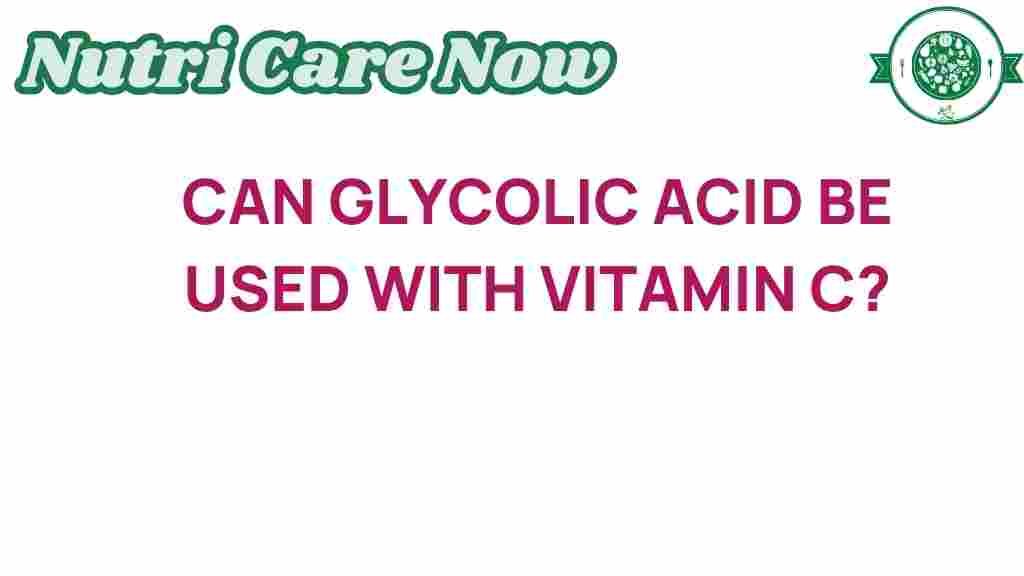Unraveling the Mystery: Can Glycolic Acid Be Used with Vitamin C?
When it comes to skincare, the combination of ingredients plays a crucial role in achieving that radiant glow. Among the myriad of ingredients available, Glycolic Acid and Vitamin C are two of the most popular. Both are celebrated for their effectiveness in anti-aging and exfoliation, but many skincare enthusiasts wonder: can Glycolic Acid be used with Vitamin C? In this article, we will explore the chemistry behind these ingredients, their compatibility, and how to safely incorporate them into your skincare routine.
Understanding Glycolic Acid and Vitamin C
To determine whether Glycolic Acid and Vitamin C can be used together, it’s important to understand what each ingredient does.
- Glycolic Acid: A type of alpha hydroxy acid (AHA), Glycolic Acid is derived from sugarcane. It works primarily as an exfoliant. By loosening the bonds between dead skin cells, it allows for easier shedding, revealing brighter and smoother skin underneath. This process promotes cell turnover, which is essential for anti-aging.
- Vitamin C: Also known as ascorbic acid, Vitamin C is a powerful antioxidant. It helps to protect the skin from free radical damage, boosts collagen production, and brightens the skin tone. Vitamin C is particularly effective in reducing hyperpigmentation and promoting an even skin tone.
The Chemistry of Glycolic Acid and Vitamin C
Both Glycolic Acid and Vitamin C are water-soluble, which sets a foundation for their compatibility in skincare routines. However, their pH levels differ significantly:
- Glycolic Acid: Typically, Glycolic Acid works best at a pH of around 3.0 to 4.0.
- Vitamin C: Vitamin C, on the other hand, is most effective at a lower pH, around 2.0 to 3.5.
This difference in pH raises concerns about whether they can be used together effectively. When combined, one ingredient may alter the pH of the other, reducing their efficacy. Therefore, understanding the timing and method of application is crucial for compatibility.
Benefits of Using Glycolic Acid and Vitamin C Together
Despite their differing pH levels, using Glycolic Acid and Vitamin C in your skincare routine can yield excellent results:
- Enhanced Exfoliation: Glycolic Acid helps to exfoliate the surface of the skin, allowing Vitamin C to penetrate more deeply and effectively.
- Brightening Effect: Both ingredients work to improve skin tone and texture, leading to a brighter complexion.
- Anti-Aging Properties: The combination can help reduce the appearance of fine lines and wrinkles, promoting a youthful look.
How to Incorporate Glycolic Acid and Vitamin C into Your Skincare Routine
To safely use Glycolic Acid and Vitamin C together, consider the following step-by-step process:
- Start with a Clean Slate: Begin your routine by cleansing your face with a gentle cleanser to remove any impurities. This prepares your skin for maximum absorption of the active ingredients.
- Apply Glycolic Acid: Use a product containing Glycolic Acid (like a toner or serum) first. This should be done in the evening. Allow it to absorb for about 10-15 minutes. This step will help with exfoliation.
- Follow with Vitamin C: In the morning, apply a Vitamin C serum after cleansing. Ensure your skin is completely dry before application to avoid any potential irritation.
- Moisturize: Lock in hydration with a suitable moisturizer after applying Vitamin C. This step is essential for maintaining skin barrier health.
- Sunscreen is Key: Always apply sunscreen during the day, especially when using exfoliating acids like Glycolic Acid that can increase sun sensitivity.
Troubleshooting Tips for Using Glycolic Acid and Vitamin C
While many people can successfully use Glycolic Acid and Vitamin C together, some may experience irritation. Here are some troubleshooting tips:
- Patch Test: Before fully incorporating new products, perform a patch test on a small area of skin to check for any adverse reactions.
- Alternate Days: If irritation occurs, consider using Glycolic Acid and Vitamin C on alternate days instead of layering them.
- Hydration is Key: Ensure you are using a good moisturizer to combat any dryness or irritation from the acids.
- Consult a Professional: If you have sensitive skin or are unsure about product compatibility, consult a dermatologist for personalized advice.
Conclusion: A Harmonious Skincare Routine
In conclusion, Glycolic Acid and Vitamin C can indeed be used together in your skincare routine, provided you are mindful of their application order and timing. Understanding the chemistry behind these powerful ingredients allows you to maximize their benefits while minimizing potential irritation.
By incorporating both Glycolic Acid and Vitamin C into your routine, you can enjoy a multitude of benefits, including enhanced exfoliation, brighter skin, and powerful anti-aging effects. Remember to listen to your skin, adjust your routine as needed, and always prioritize hydration and sun protection.
For more tips on building an effective skincare routine, check out our skincare guide. And for scientific insights on skincare ingredients, visit Skincare Science.
With the right approach, you can unravel the mystery of using Glycolic Acid and Vitamin C together and enjoy the beautiful, healthy skin you deserve!
This article is in the category Trends and created by NutriCareNow Team
